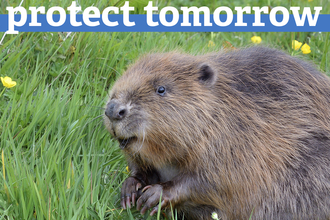Cheshire's Last Refuges Appeal
Nature reserves are some of the last refuges where wild plants, mammals, birds and insects are given the space they need to survive. The 34 nature reserves cared for by Cheshire Wildlife Trust are some of the best wildlife havens remaining across the region. Our nature reserves are homes for water voles, breeding grounds for lapwings and overwintering shelter for bitterns.
Can you help us protect Cheshire’s last wildlife refuges?
We work really hard to be as effective as possible and to apply for as much funding as possible for land management. However, it costs us £404,068 each year to manage our nature reserves for wonderful wildlife
Could you help us protect our nature reserves for just £44 per acre for a whole year?
What your donations could do
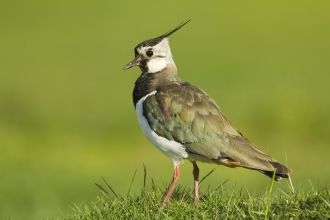
Donate £66
£66 could help protect 1.5 acres of farmland habitat for breeding lapwings for a whole year.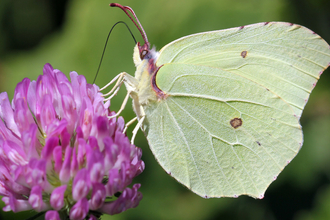
Donate £44
£44 could help protect an acre of meadow for butterflies like brimstones for a whole year.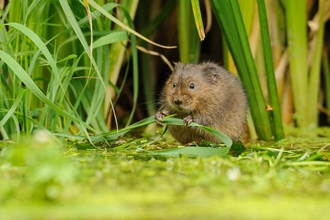
Donate £22
£22 could help protect 1m of river for water voles for a whole year.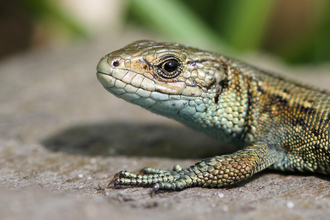
Donate £2,500
£2,500 could help protect a wildlife refuge like Danes Moss Nature Reserve for common lizards a whole year.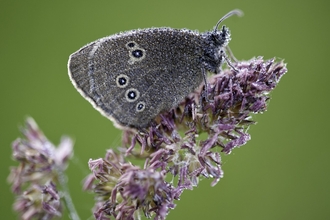
Donate £979
£979 could help protect a wildlife refuge like Swettenham Valley Nature Reserve for butterflies like ringlets for a whole year.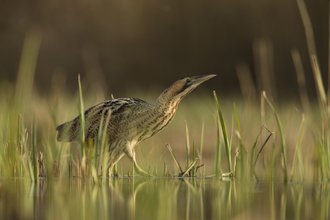
Donate £652
£652 could help protect a wildlife refuge like Marbury Reedbed for bitterns for a whole year.Your gift today could support these wildlife refuges
Gowy Meadows Nature Reserve - A last refuge for water voles
Gowy Meadows Nature Reserve, near Ellesmere Port, is our largest nature reserve. This 410-acre reserve provides an extensive network of wildlife-rich ditches, hedgerows, wet grassland, ponds and scrapes where over 150 bird species have been recorded! The river Gowy also runs through the reserve and is home to aquatic invertebrates, dragonflies, otters and water voles.
Sadly, water voles are one of the UK’s fastest declining mammals. Up to 90% of the population has been lost since the 1970s due to habitat loss and fragmentation. If we are to prevent further losses, and even localised extinctions, we need to increase, improve and reconnect their habitat. Water voles are a vital part of river ecosystems. Their burrowing, feeding and movements help create conditions for other animals and plants to thrive.
Senior Living Landscape Officer, Jack, leads on our work at Gowy Meadows: “We carry out a wide variety of work to support water voles at Gowy Meadows. For example, I've created ponds near to the ditches where we know the water voles are living. The ponds allow for different types of aquatic plants to grow, providing excellent food and shelter for the water voles.
"With your donation, I’ll also be able to restore a network of old river channels, connecting them to other watercourses to allow water voles to move more freely. I've set up some cameras to see how they're getting on, so hopefully we’ll capture some exciting footage!”
Water vole conservation status: Protected in the UK under the Wildlife and Countryside Act, 1981. Priority Species under the UK Post-2010 Biodiversity Framework. Water voles are listed as endangered on both the Great Britain and the England Red List for Mammals.
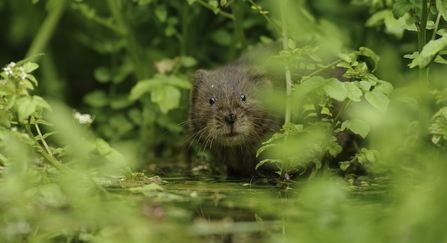
Water vole © Terry Whittaker/2020VISION
Danes Moss Nature Reserve - A last refuge for common lizards
Danes Moss Nature Reserve, near Macclesfield is the largest and highest lowland raised bog n Cheshire and a designated Site of Special Scientific Interest (SSSI). The open areas of the bog are covered with cotton grass, cross-leaved heather and at least six species of sphagnum moss. The sphagnum mosses are especially important as the remains of dead plants accumulate to form peat. This is one of the scarcest and most threatened habitats in the UK.
The reserve is home to a whole host of dragonflies, damselflies, butterflies and common lizard. Reptiles, such as the common lizard, are suffering global declines and are threatened with extinctions. In fact, common lizards are a protected species under the Wildlife and Countryside Act.
Reptiles can be particularly vulnerable because they tend to live in small, isolated areas and need places to shelter and hibernate. However, they do also need open areas to bask in the warm sunshine! Their habitat being divided up by built up areas and farmland makes it difficult for populations to spread out.
Living Landscape Officer, Jamie, manages our work at Danes Moss: “The priority for our work at Danes Moss is to maintain the bog habitat. I do this by removing birch scrub from the moss to retain moisture. We then move the cut birch stems into the woodland to provide deadwood habitat piles.
"With your donation, I'll also be able to do some woodland thinning on the reserve which allows more sunlight to penetrate through the canopy, which in turn encourages species like oak and rowan to become better established in the woodland.
Common lizards like to bask on the exposed surfaces like the boardwalk, as well as on the edge of the woodland. They benefit from the work we do to maintain the bog. Brash piles provide space to hibernate, maintaining open areas on the moss provides space for basking in the sunshine and holding water on the reserve provides habitat for invertebrates such as spiders, flies and beetles, which common lizards feed on."
Common lizard conservation status: Protected in the UK under the Wildlife and Countryside Act, 1981. Priority Species under the UK Post-2010 Biodiversity Framework.
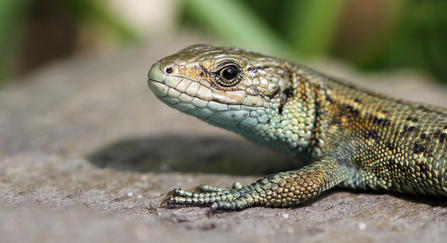
WildNet - Jon Hawkins - Surrey Hills Photography
Swettenham Valley Nature Reserve - A last refuge for butterflies
Swettenham Valley Nature Reserve, near Holmes Chapel, is one of Cheshire’s hidden gems. A mosaic of habitats including ancient woodland, a network of ponds and species-rich meadows. Together, these habitats support an abundance of wildlife, most notably valuable populations of 18 resident species of butterfly, including brimstones, ringlets and small skippers.
Insects, including butterflies, pollinate around 85% of our crops and are an indicator of a healthy environment. They’re also important parts of the food chain, providing food for birds, bats and small mammals. However, half of British butterflies are now classed as either threatened or near threatened with extinction. This is due to habitat loss and fragmentation, as well as the climate crisis causing extreme weather events.
Senior Living Landscape Officer, Ralph, leads our work at Swettenham:
“With a mix of woodland and grassland, Swettenham provides an excellent habitat for many species of butterfly. With your donation, I'll be able to create more open grassland habitat, providing food and shelter for butterflies and other pollinators. By creating small clearings along the edge of the woodland areas, I’ll also be able to create a sunny microclimate which is perfect for sun-loving butterflies and encourages lots of beautiful plants and wildflowers.
We’ve been working with volunteers to clear Himalyan balsam. The vivid flowers look pretty and attract nectar seeking insect species. In doing so, they can distract these insects from out native wildflowers which rely on them for pollination. Removing the invasive balsam means that our native plants have less direct competition and will be more successful at reproducing with the help of butterflies, bees and hoverflies.”
Butterfly conservation status: The latest Red List assessment has revealed a 26% increase in the number of species threatened with extinction and a 76% decline in butterfly abundance since 1976.
©Les Binns
Marbury Reedbed Nature Reserve - A last refuge for bitterns
Marbury Reedbed, near Northwich, is a reedbed and woodland sitting within Marbury Country Park, on the western edge of Budworth Mere (a Site of Special Scientific Interest, SSSI).
The open water contains a rich selection of plants including water lilies and provides valuable feeding and breeding habitat for kingfishers and grebes. The reedbed is also used as an over-wintering site for bittern.
Bitterns are one of the rarest breeding birds in the UK. A shy breed of heron, they spend almost all their time hidden away in reedbeds. They’re more likely to be heard than seen, thanks to the male’s ‘booming’ mating call. They are threatened by wetland drainage and habitat loss and were once on the brink of extinction in the UK. In 1997 there were just 11 males left. However, the good news is that populations are increasing, thanks to the protection of key breeding sites such as Marbury Reedbed.
Living Landscape Officer, Graham, manages Marbury Reedbed:
“We close public access between October and March to protect overwintering bitterns from disturbance. During this time, I can clear the inflow to the reedbed to ensure it’s a healthy, safe habitat. Bitterns favour open reedbed, so at the end of each summer we cut different sections of the reedbed to open up channels and corridors. This work provides different habitats for a variety of wildlife to exploit and prevents the reedbed becoming overgrown. Your donation will enable me to carry out all of these works and much more including removing encroaching willow which, if left, would slowly develop into wet woodland.”
Bittern conservation status: Classified in the UK as Amber under the Birds of Conservation Concern 5: the Red List for Birds (2021). Protected in the UK under the Wildlife and Countryside Act, 1981. Priority Species under the UK Post-2010 Biodiversity Framework.
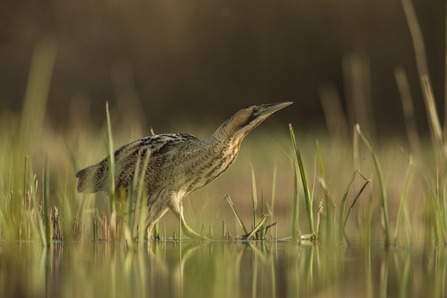
Bittern c. Jamie Hall
Bickley Hall Farm - A last refuge for lapwings
Surrounded by beautiful Cheshire countryside, Bickley Hall Farm sits just outside the village of Malpas and is managed as an organic, nature-friendly farm in partnership with a local grazier. The 210—acre reserve boasts species-rich meadows, wet grassland, pastures and diverse hedgerows. These habitats are great for invertebrates, small mammals and in particular, hundreds of feeding farmland birds like lapwing in autumn and winter.
Lapwings have suffered a serious decline as a breeding species across the UK. Changes in farming methods have led to habitat loss. Drainage of wetlands and a reduction in uncultivated grassland have also contributed to these declines. Although some birds will head to continental breeding grounds in the spring, for those that stay in the UK, the ponds, wetlands and hay meadows at Bickley Hall Farm provide them with excellent breeding habitat.
Land Management Officer, Darren, manages our work at Bickley Hall Farm: “I love working at Bickley Hall Farm, especially in the autumn months with such an array of colours, listening to the pink-footed geese flying overhead and the arrival of overwintering birds. With your donation, I’ll be doing some hedge laying this winter and, creating more wader scrapes on the floodplain grazing marsh habitat on the farm. Waders, such as lapwings, prefer to nest on bare ground or in short grass so that they can see predators more easily. Working with our grazing partner to ensure the grass is grazed by the cattle to just the right height coming into early spring is really important. The new ponds and wader scrapes will also help lapwings to feed themselves and their young.”
Lapwing conservation status: Classified in the UK as Red under the Birds of Conservation Concern 5: the Red List for Birds (2021). Priority Species under the UK Post-2010 Biodiversity Framework. Listed as Near Threatened on the global IUCN Red List of Threatened Species.
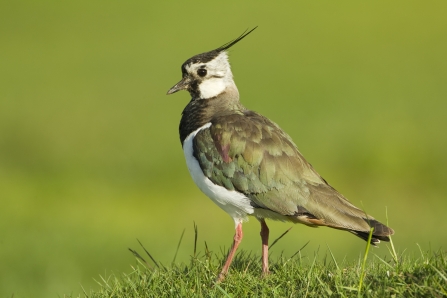
Lapwing c. Mark Hamblin/2020VISION
UK nature is in decline
Pressures from development, pollution and invasive species are threatening our precious native wildlife. The 2023 State of Nature report shows that nature is continuing to decline at an alarming rate across the UK, which is already one of the most nature-depleted countries in the world.
More than half of the UK’s species are in decline: one in six species is now at risk of being lost, 41% of our insects are classed as threatened, one in five of our mammals face a high risk of extinction and in Cheshire, we’ve lost 99% of the wildflower meadows we had in 1960. Important habitats are in poor condition and homes for wildlife are being lost.
But there is hope.
Find out more
Can my money go towards a specific nature reserve?
Funds raised through this appeal will be used for managing nature reserves across the region. If you would like to help us to manage a specific nature reserve for at least a year, please get in touch with Jen Wood, Communications and Individual Giving Programme Manager.
What if we exceed our target?
If we exceed our target and raise more than needed, funds will be used where the need is greatest to do even more for wildlife’s recovery locally, on our nature reserves and beyond.







